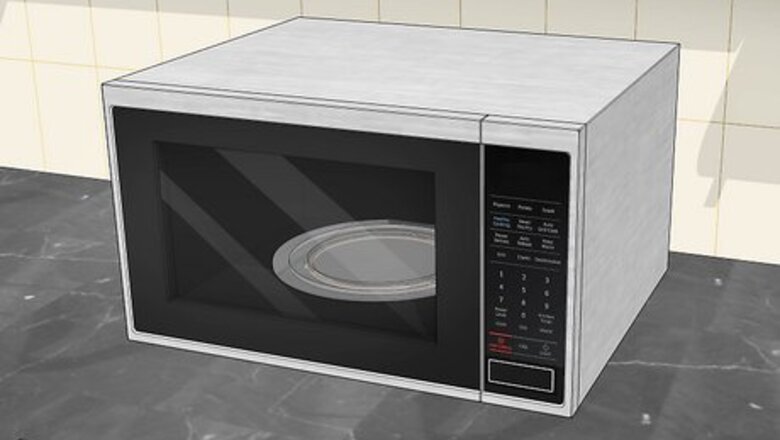
views
Setting up the Microwave
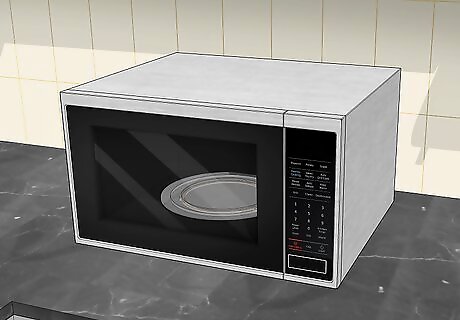
Place the microwave on a flat, dry surface. A clean counter in your kitchen or a solid, wooden table would be good for the microwave. Do not put the microwave near a gas or electric range, such as your stove. Make sure the microwave’s air vents on one side are not being blocked.
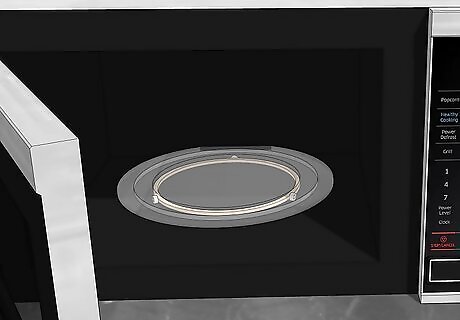
Check that the roller ring and glass tray are secure in the microwave. Most microwaves will come with a plastic roller ring and a round glass tray. The roller ring and the glass tray should fit inside the microwave. The glass tray should spin around on the roller ring easily and smoothly.
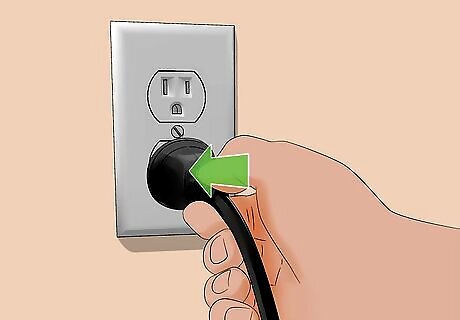
Plug the microwave into a grounded wall outlet. Make sure the outlet is rated for 20 A. This will ensure it is safe to use to power the microwave. Note that a microwave from one country may not work or become damaged in another country. In the Americas and Japan, the outlets are usually rated for 110 V 60 Hz. In Europe, Asia, and the rest of the world, the outlets are usually rated for 220 V 50 Hz. Pick an outlet that is not already being used by another appliance or electronic device.
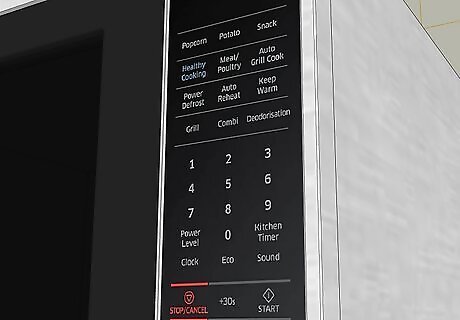
Look at the features on the microwave. Check for numbers on the front of the microwave from 1-9. You can use these numbers to enter in your desired cooking or heating time. There should also be a Start button on the front that you can use to start the microwave. Most microwaves will also have a clock on them that you can set using the instructions that came with the microwave. Depending on the model, the microwave may have settings for reheating, defrosting, and cooking food. These settings will automatically heat your food based on whether you want to reheat it, defrost it, or cook it.
Warming up Food in the Microwave
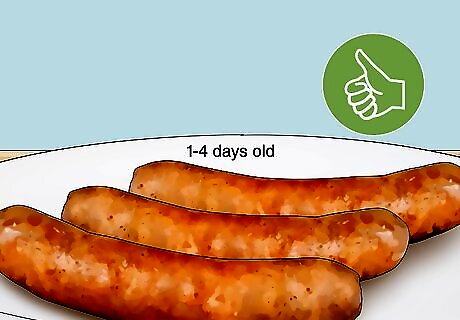
Reheat leftovers that are 1 to 4 days old. Leftovers that are 5 days or older should not be reheated or eaten, as they likely have gone bad or contain too much bacteria to be eaten safely.
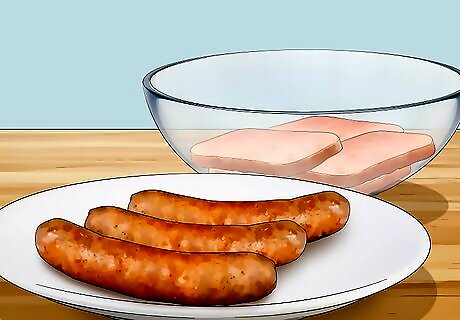
Arrange food in a ring on a ceramic plate or in a glass bowl. Piling the food in the middle of a plate or bowl will cause the food on the edge of the plate to heat up faster than the food towards the center of the plate. Avoid this by pushing the food into a ring on the edge of the plate or bowl. This will allow the food to heat up evenly. Always warm up food in the microwave in ceramic or glass containers. Plastic containers can melt and contaminate your food. Metal containers can spark in the microwave and are a fire hazard. Avoid using any ceramic or glass containers that have gold trim or metal pieces, as they will spark in the microwave.
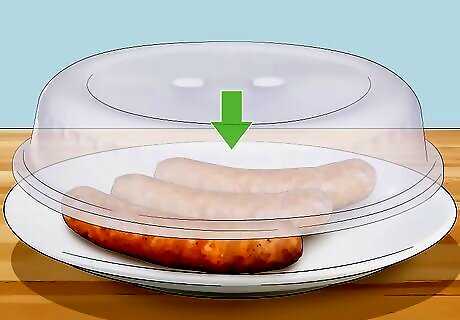
Cover the food with a thick plastic cover. Prevent the food from splattering all over the microwave by covering it before you warm it up. Use a thick, domed cover made of durable plastic that is designed for use in the microwave. You can get plastic microwave covers online. The plastic cover will also help to keep steam in as you warm up the food, making it less likely to become dry in the microwave. You can also use a paper towel or wax paper over the food in a pinch. Do not leave the paper towel on the food for more than one minute, as it is at risk of burning if left in the microwave for longer.
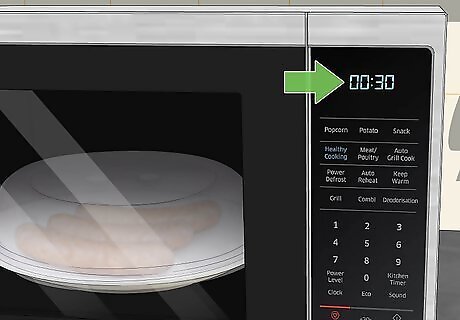
Warm the food a little at a time. It can be tricky to know how long to warm up cooked food in the microwave. Start by heating the food for one minute. Then, take it out of the microwave and check it to see if it is warm enough for you. Stir the food, look for steam coming from the food, and taste it to see if it is warm enough. If the food is not warm enough for you, put it in for another 30 seconds to one minute. Continue heating the food up in intervals of 30 seconds to one minute until it is warm enough. Heating up the food a little at a time will ensure you do not overheat the food or ruin its flavor.
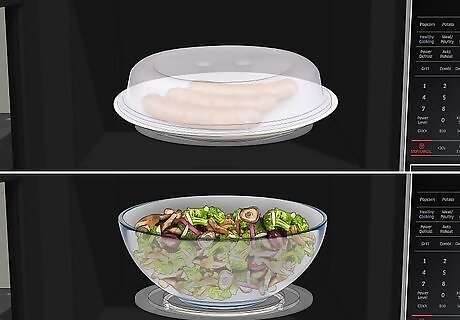
Heat up certain foods separately so they do not become soggy or dry. Depending on what you are reheating, you may need to deconstruct your leftovers and warm up different foods separately. Heat up dense items first, such as meats, as they take longer to warm up. Then, add less dense items like cooked pasta or vegetables to the plate and warm them up. For example, if you are reheating a burger, put the patty on a plate and heat it up in the microwave. Then, add it to the bun. Microwaving the burger with the bun will make it soggy.
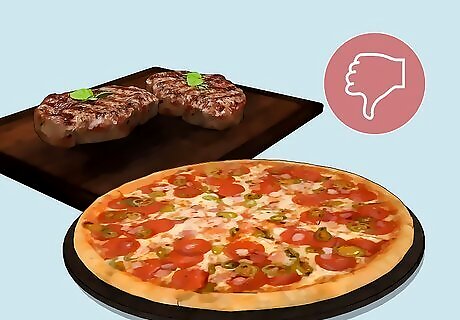
Do not reheat pizza, casseroles, or meat in the microwave. Some cooked foods do not do well in the microwave, as they can become soggy or dry. Rather than pop a leftover piece of pizza in the microwave, warm it up on a baking sheet in the oven instead. Warm up casseroles in the oven by putting a dash of water on it and covering it with foil until it is bubbly hot. Avoid reheating cooked meat like beef, chicken, or pork in the microwave, as it will become very dry and rubbery. Instead, reheat meat in the oven or in a skillet on the stove.
Cooking Food in the Microwave
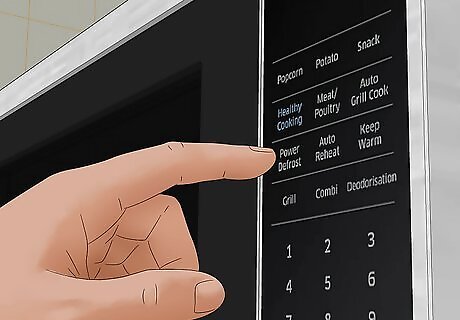
Defrost microwave dinners and frozen food in the microwave. Follow the instructions on the label of microwave dinners for the proper cook time. Your microwave may have a defrost button that you can use to cook frozen food. You can also try cooking the food with the following ratio: 7 minutes for each pound of food. Always put frozen foods in a ceramic or glass container before defrosting them in the microwave. Make sure you stir the food around once it has cooked to confirm there are no frozen or cold spots. If there are, put the food back in the microwave for 30 seconds to 1 minute so it cooks through.
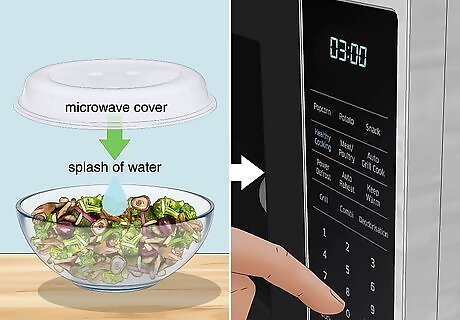
Steam vegetables in the microwave. Put uncooked vegetables like broccoli, carrots, and cauliflower on a ceramic plate or in a glass bowl. You can add a splash of water or a small amount of butter to the vegetables to help them steam. Cover the vegetables with a microwave cover. Then, cook the vegetables in the microwave for 2-3 minutes. Stir the vegetables and cook them for 1 minute intervals until they are steamed through. You can add black pepper, salt, and other spices to the steamed vegetables for more flavor once they are cooked.
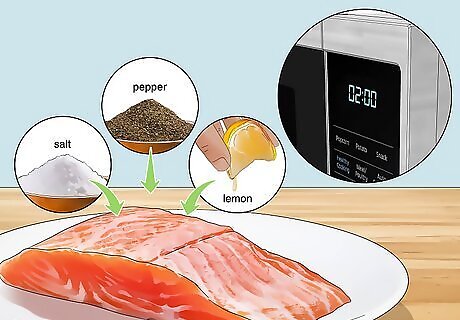
Cook fish. Season uncooked fish with salt, pepper, and a squeeze of lemon. Then, place it on a ceramic plate and wrap it in microwave-safe plastic. Cook it for 1-2 minutes in the microwave until it turns white at the edges and lighter in color. Watch the fish closely as it cooks to ensure you do not overcook it. The cook time for the fish will depend on the size, shape, and thickness of the fillet.
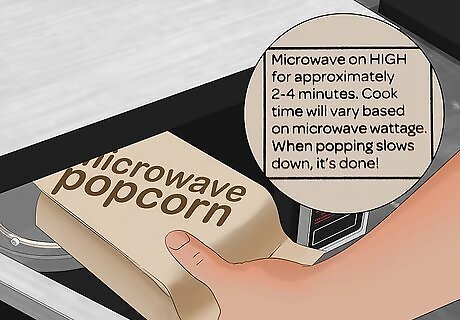
Make microwave popcorn. Read the instructions on the label for the proper cook time for the popcorn. You will need to open the tabs on the bag and place the bag right side up in the microwave. Then, cook the popcorn until you hear it pop and it is steaming hot. Some microwaves will have a button specifically for cooking popcorn.
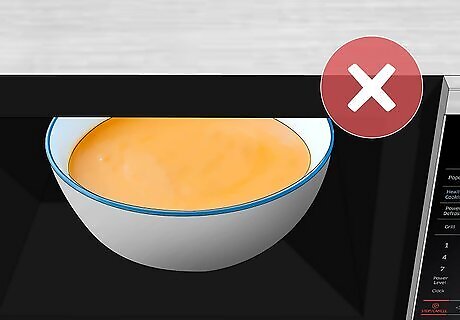
Do not cook soups or sauces in the microwave. Soups and sauces are prone to overheating and exploding when cooked in the microwave. Prepare them on the stove instead to avoid an explosion in your microwave.
Maintaining the Microwave
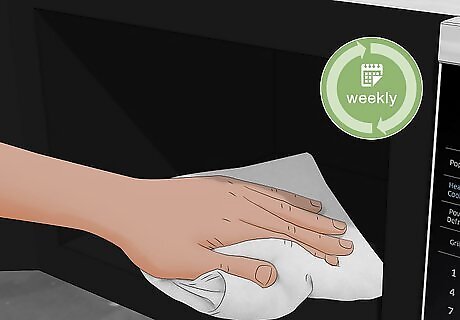
Clean the microwave once a week. Use a damp cloth to wipe down the inside of the microwave well. Remove bits of food in the microwave by using a natural cleaner like baking soda and water. You can also combine water and mild dish soap to clean the microwave. Get in the habit of cleaning the microwave once a week so it stays clean and works well.
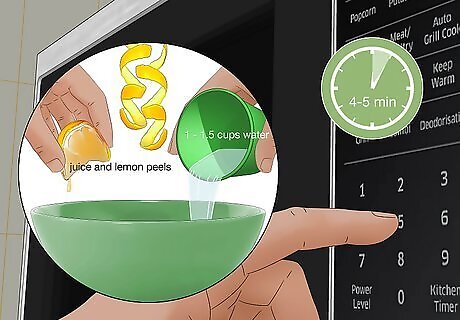
Remove cooking odors with water and lemon. After a while, your microwave can start to smell, especially if it is not cleaned regularly. Remove odors by putting 1 to 1.5 cups (240 to 350 ml) water and the juice and peels of one lemon in a glass bowl. Then, place the bowl in the microwave and warm it up for 4-5 minutes. Once the water has finished boiling, use oven mitts to remove it from the microwave. You can then take a clean cloth and give the inside of the microwave a final wipe down.
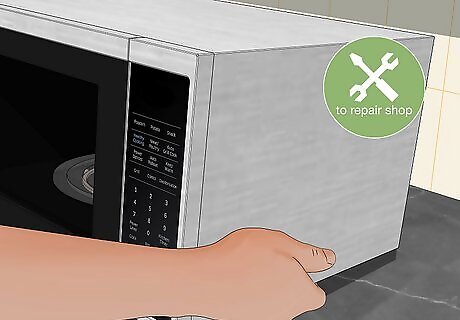
Take your microwave in for repairs if it develops issues or stops working. If you notice your microwave is not heating up food properly or it takes a very long time to cook foods, bring it to a repair shop. You can also contact the manufacturer of the microwave for repairs, especially if you have a warranty for the appliance. Do not use a microwave that sparks or smells of burning. Unplug it and take it in for repairs so you can be sure it is safe to use.


















Comments
0 comment